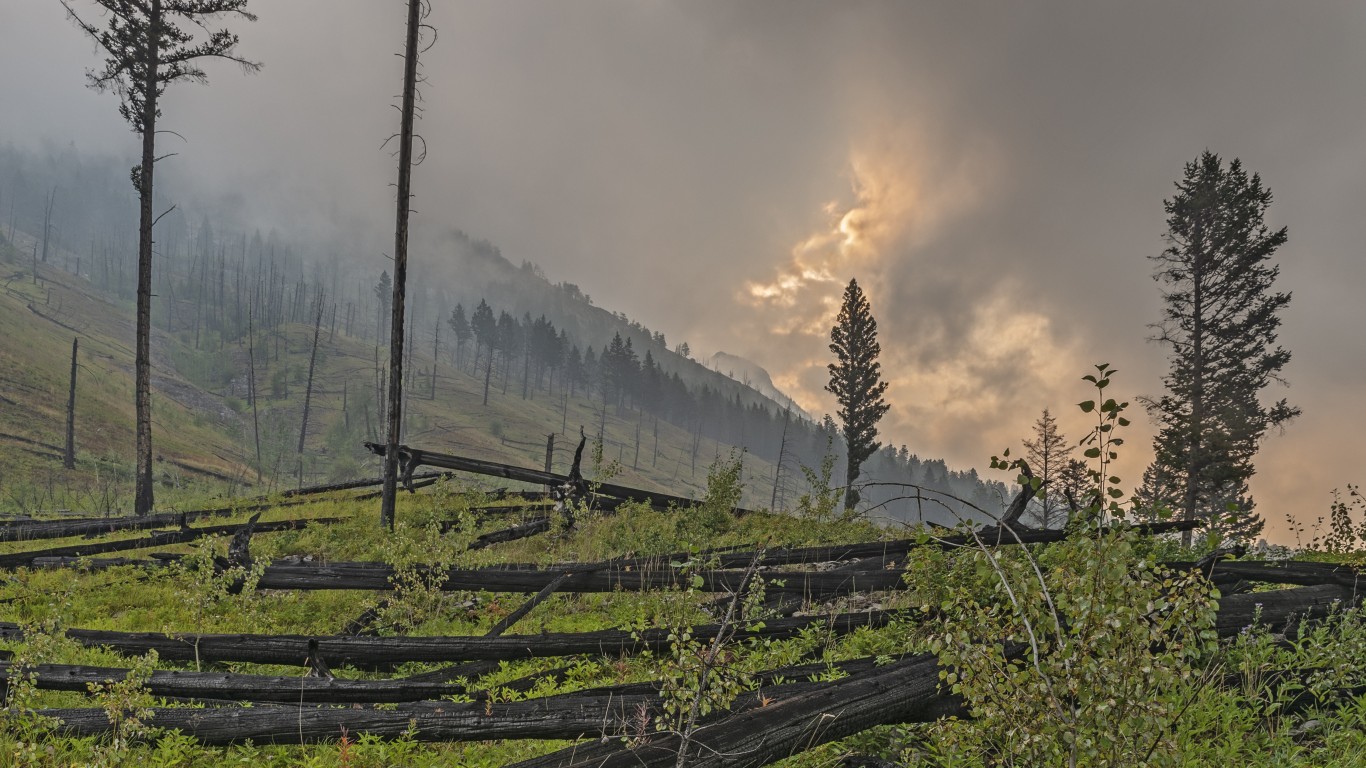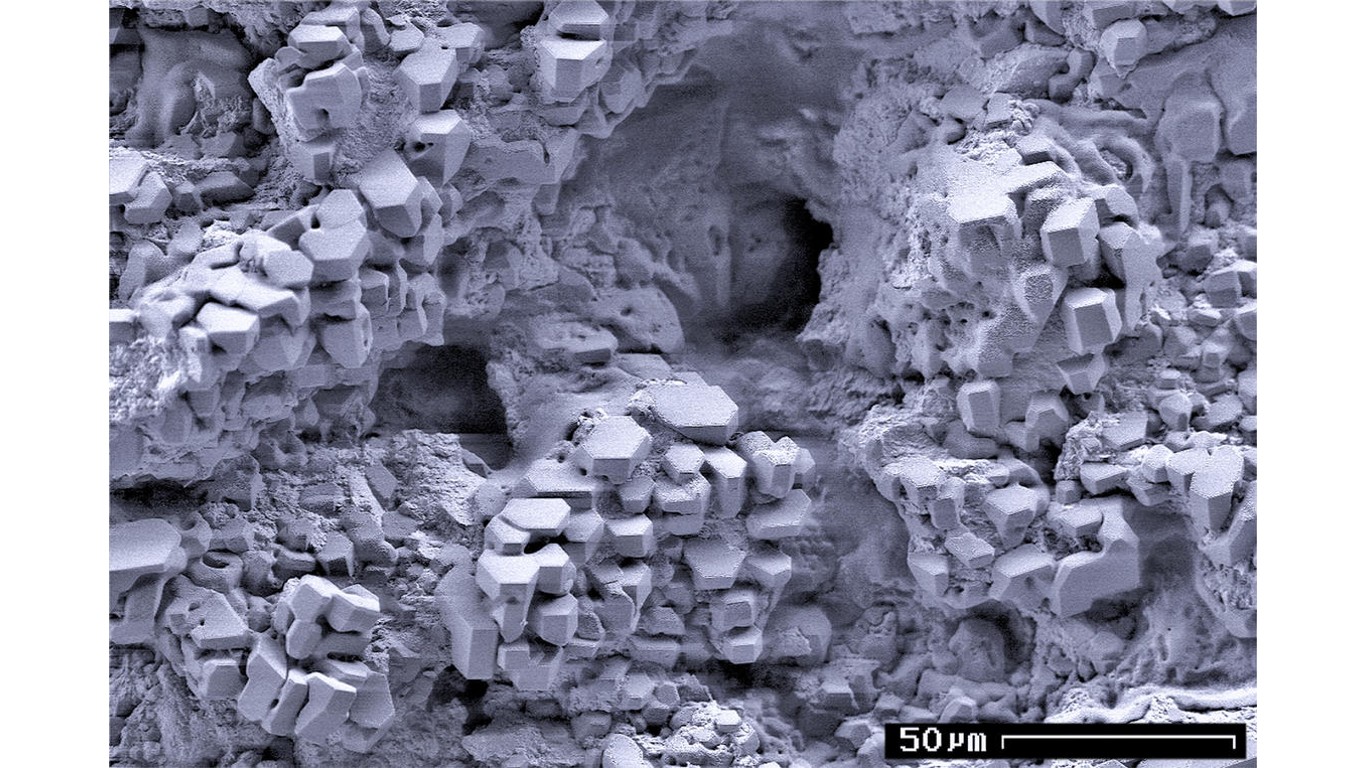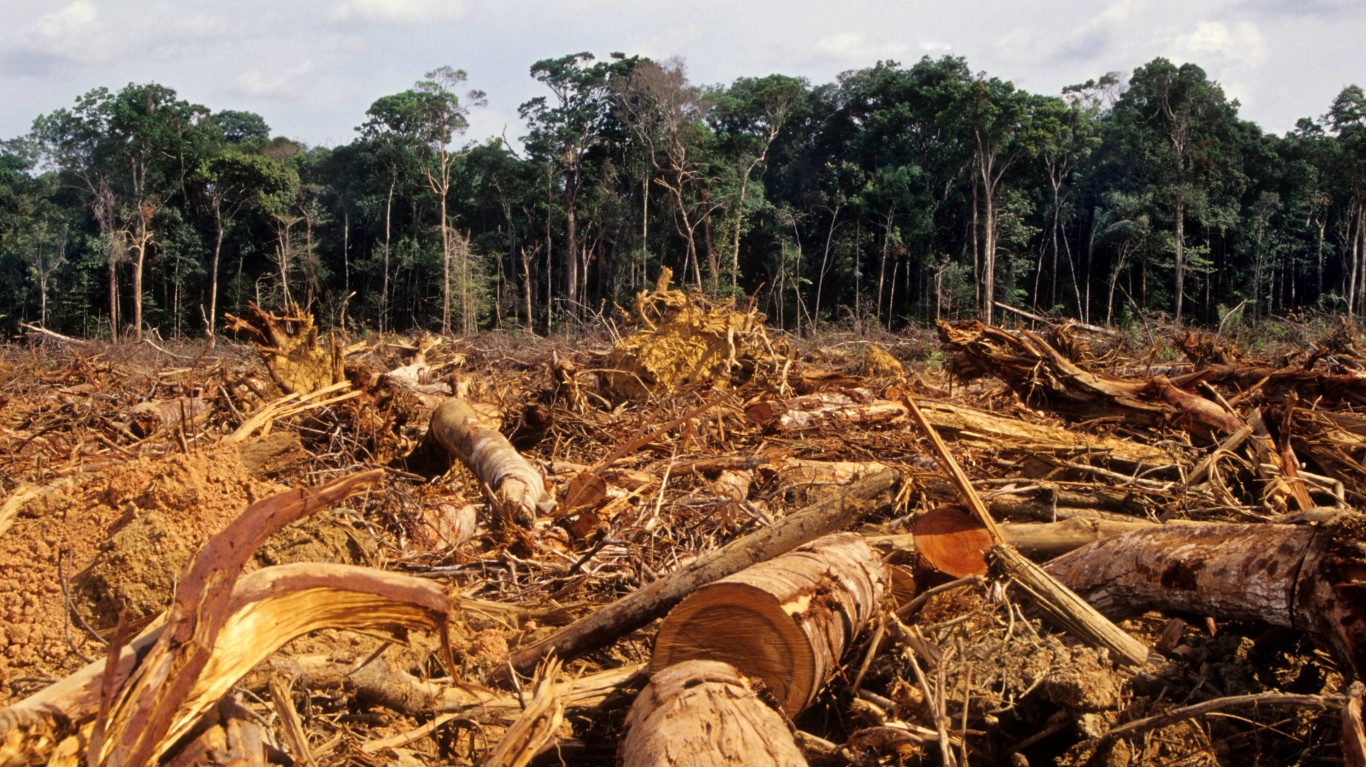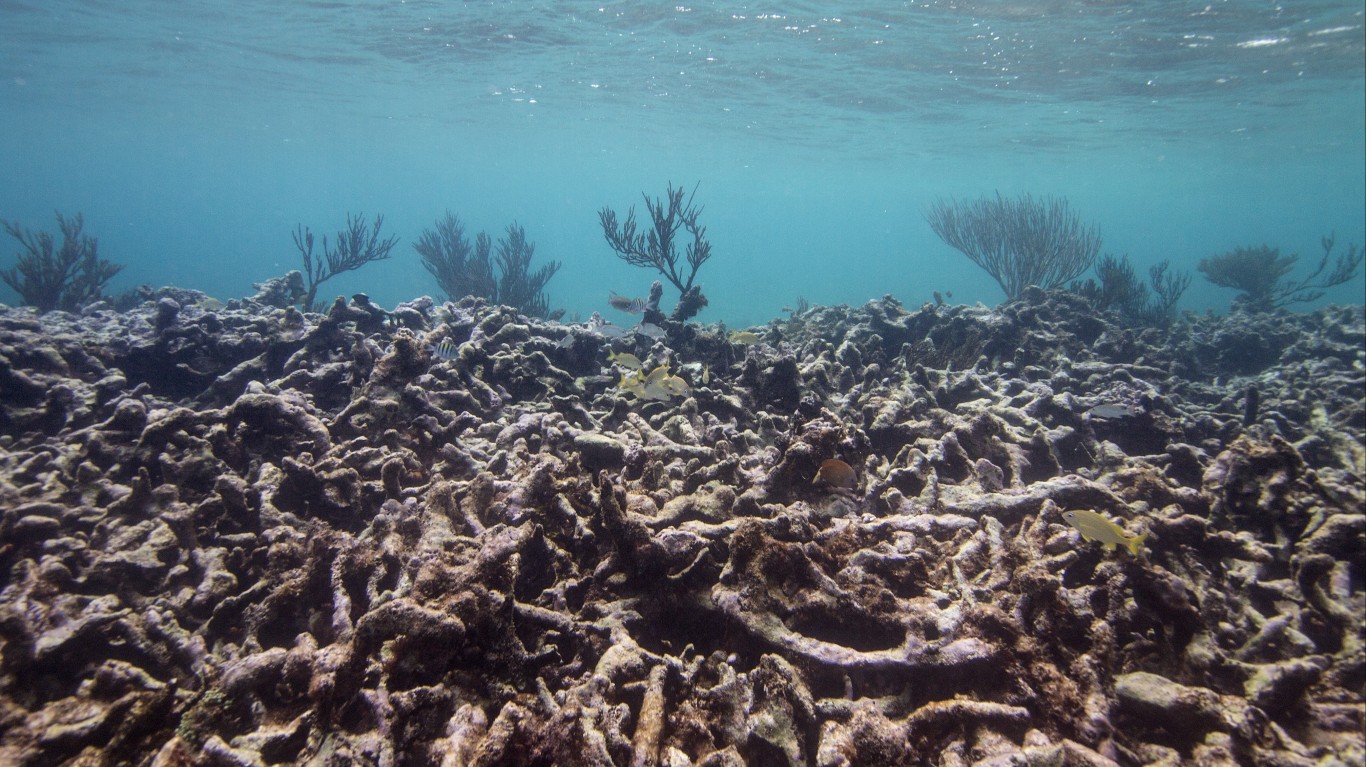Special Report
10 Climate Tipping Points the World Needs to Avoid at All Costs

Published:

Human-caused climate change is one of the biggest concerns the planet faces in the 21st Century. Renowned naturalist David Attenborough told the U.N. Security Council in February 2021 climate change is “the biggest threat to security that modern humans have ever faced,” while a World Health Organization report from October 2021 said it is the “single biggest health threat facing humanity.” (Here are cities around the world that will soon be underwater.)
Climate change affects everything from regional biodiversity to global crop yields and its effects can be witnessed in seasonal fires in boreal forests of North America, more powerful and frequent Atlantic storms, Amazon rainforest turning into savannah, and Greenland melt.
To identify the 10 climate tipping points the world needs to avoid at all costs, 24/7 Wall St. reviewed the scenarios outlined in Environment of Peace: Security in a New Era of Risk, a report published by Stockholm International Peace Research Institute on May 22, 2022.
In 2020, scientists discovered a new source of greenhouse gas emissions off the coast of East Siberia, as warmer waters causes the seafloor to release ice-encased methane, a potent source of global warming. According to the U.S. Geological Survey, the so-called Arctic hydrate destabilization is one of the most serious scenarios for abrupt climate change that has implications far beyond the melting ice of the polar north. (These are the 20 countries responsible for nearly all global emissions.)
The globe has many environmental tipping points, where prevention of a climate disaster could turn into resignation and mitigation. For example, a 2018 study published in the journal Earth System Dynamics said the world was reaching a point of no return after which it would be impossible to prevent the catastrophic effects of a 2-degree Celsius rise in global temperatures (from pre-industrial levels), something the Paris Agreement international treaty is aiming to prevent.
Here is the worst climate tipping point the world needs to avoid
1. Arctic
> Tipping point: Reduction in sea ice area
The Arctic loses about 13% of its sea ice every decade, according to the World Wildlife Fund. The region could be ice free in the summer by 2040, making the Arctic one of the most at-risk environments. The Arctic ice cover helps in maintaining Earth’s temperature as the ice reflects light and heat that the ocean would otherwise absorb, keeping the Northern Hemisphere cool, The National Snow and Ice Data Center explains. Loss of Arctic sea ice could lead to further Arctic warming, erosion of Arctic coastlines, and a disturbance of global weather patterns.
[in-text-ad]
2. Greenland
> Tipping point: Ice sheet loss
When land-based ice sheets melt into the oceans they cause sea levels to rise. Greenland is basically a gigantic ice sheet planted on the world’s largest island. According to NASA, Greenland loses 283 gigatonnes of ice per year, and the Greenland Ice Sheet holds enough water to raise the sea level by 24 feet (7.4 meters).
3. Siberia
> Tipping point: Permafrost thawing
Global warming is having a profound effect on Siberia, the vast and sparsely-populated region of Russia that stores immense amounts of methane in its porous frozen limestone. The region has confronted warmer winter temperatures and seasonal summertime fires. Thawing permafrost in the region has resulted methane, a potent greenhouse gas, being unlocked from the soil at such a rapid pace that scientist call it a “methane time bomb” that is accelerating global warming.

4. Boreal Forest (Canada)
> Tipping point: Lost due to fire
Boreal forests span the frigid subpolar regions of the world, including vast parts of Canada, and like all forests they play an important role in absorbing carbon dioxide. Annual fires in western Canada are disrupting this ecosystem and unlocking its carbon into the atmosphere. In May and June 2019, observers counted more than 17,000 fires in the province of Alberta, the highest number in 20 years.
[in-text-ad-2]

5. Methane clathrates (Pacific Ocean)
> Tipping point: Releasing methane
Methane, a hydrocarbon byproduct of the microbial decay of organic matter, is a potent greenhouse gas. It is locked in the frozen soils of Siberia and trapped beneath the sea floor within the molecular lattice of ice, a solid known as a methane clathrate. As the oceans warm, this methane is released from its icy cells.
6. Atlantic Ocean
> Tipping point: Slow down of circulation
The Atlantic Meridional Overturning Circulation, or AMOC, is a complex network of currents in the Atlantic Ocean that delivers warmer tropical waters north and cooler waters south in a giant conveyor belt between the Americas and Europe/Africa. Global warming and changes in seawater salinity is weakening the AMOC. This slowdown is one reason why areas of the North Atlantic can experience colder winters as the AMOC weakens.
[in-text-ad]

7. Indian Ocean
> Tipping point: Global monsoons destabilizing rain patterns
As the Atlantic Ocean is becoming profoundly changed by global warming, on the other side of the world the situation may be worse. Human-caused climate change threatens to re-awaken a geologically ancient weather pattern that makes monsoons stronger and droughts more frequent as Indian Ocean temperatures become more volatile. This would disproportionately affect the world’s most vulnerable to climate change.

8. Amazon Basin
> Tipping point: Drought and dieback
Far away from the sub-Arctic environmentally important boreal forests of Canada, Alaska, and Russia is the Amazon Basin that covers a massive area across eight South American countries. This region has played an outsize role in storing the world’s carbon dioxide into its ecosystem. But deforestation and climate change are increasing droughts and dry seasons. As rainforest is turned into savannah by these forces, with devastating effects to its biodiversity in a phenomenon known as “dieback,” more carbon is being released while the Amazon Basin’s ability to absorb carbon is greatly diminished.

9. East coast of Australia
> Tipping point: Large scale die-off of coral reefs
The bleaching of Australia’s vast coral reef system along its eastern coast is caused by global warming. Coral reefs, which are often referred to as “rainforests of the sea” are among the most vulnerable to climate change and changes in water acidity. The world’s oceans have been absorbing large amounts of carbon dioxide, which increases the water acidity. Reefs support local tourism and the commercial fishing industry. They also protect coastlines from flooding during extreme storms.
[in-text-ad-2]
10. East and West Antarctica
> Tipping point: Ice shelf loss
Though NASA says Greenland loses almost twice as much ice than the Antarctic, the warming of both polar environments — one in the north and the other in the south — is contributing massively to sea level rises. Ice shelves are enormous ice sheets that hug the land, and the Antarctic has many of them. In March, an ice shelf the size of New York City collapsed off East Antarctica. It was the first time humans had observed this phenomenon on the continent.
The thought of burdening your family with a financial disaster is most Americans’ nightmare. However, recent studies show that over 100 million Americans still don’t have proper life insurance in the event they pass away.
Life insurance can bring peace of mind – ensuring your loved ones are safeguarded against unforeseen expenses and debts. With premiums often lower than expected and a variety of plans tailored to different life stages and health conditions, securing a policy is more accessible than ever.
A quick, no-obligation quote can provide valuable insight into what’s available and what might best suit your family’s needs. Life insurance is a simple step you can take today to help secure peace of mind for your loved ones tomorrow.
Click here to learn how to get a quote in just a few minutes.
Thank you for reading! Have some feedback for us?
Contact the 24/7 Wall St. editorial team.